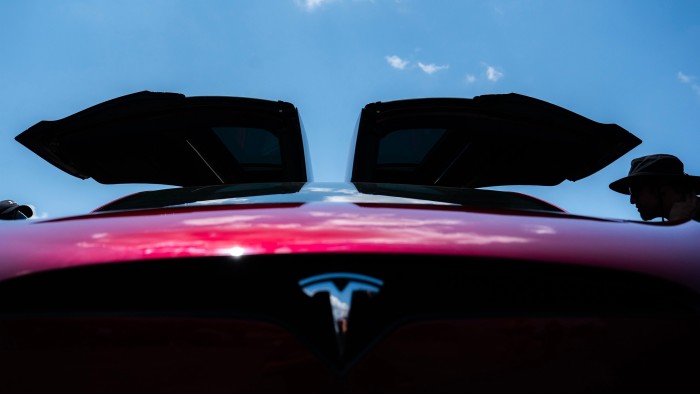3x Tesla ETP fails to deliver promised returns in June

Simply sign up to the Exchange traded funds myFT Digest -- delivered directly to your inbox.
Latest news on ETFs
Visit our ETF Hub to find out more and to explore our in-depth data and comparison tools
Investors have been left out of pocket by what appears to be an unprecedented technical glitch at one of Europe’s largest leveraged exchange traded products.
Leverage Shares’ highly popular $320mn 3x Tesla ETP (TSL3), which aims to provide returns equal to three times the daily movement in the share price of the electric-vehicle manufacturer, before fees, ran into trouble last month.
For six trading days it was unable to provide the full three times leverage due to “technical issues with the margin loan provider”, it said in filings to the London Stock Exchange, one of four European bourses on which it is listed.
At one point leverage fell as low as 2.8 times, before eventually being restored to the advertised three times.
The glitch is likely to have cost investors money given that Tesla’s share price rose on four of the six days in question, including chunky gains of 4.1 per cent and 3.6 per cent on June 9 and 13 respectively, gains that would have been magnified by the leverage. Given that the reduced levels of leverage were communicated to the stock exchange before each day’s trading, investors could potentially have compensated by buying more units of the ETP, but only if they were aware of the filings.
“It was a curious thing,” said Will Rhind, chief executive of GraniteShares, a rival provider of leveraged and inverse ETPs, who said he was unaware of a similar issue with an ETP anywhere in the world.
“This is clearly a faulty product, which reflects very poorly on Leverage Shares and further highlights the increased risks associated with using leveraged ETPs,” said Kenneth Lamont, senior fund analyst for passive strategies at Morningstar, who has likened leveraged and inverse ETPs to a “casino”.
The episode comes amid a boom in demand for leveraged and inverse ETPs, with global net inflows hitting a record $28bn last year, equivalent to 3.7 per cent of all purchases of ETPs, outstripping the previous highs of $17.1bn and 2.3 per cent in 2020, according to data from Morningstar.
Rhind suggested the problem may have emanated from Leverage Shares’ operational structure.
Most European leveraged and inverse ETP providers, including GraniteShares, use swap contracts to gain the necessary leverage, posting collateral with a partner investment bank.
However, Leverage Shares uses a physically backed model, using investors’ funds to physically buy the underlying stock. This means it needs to borrow additional funds in order to purchase enough shares to generate the necessary leverage.
The filings suggest Leverage Shares was struggling to access the financing necessary for this leverage, perhaps related to the outsized scale of its 3x Tesla product compared with its other offerings.
“Whoever is facilitating that [margin provision] for them, that might be more difficult to do than if you have an investment bank that can manage a large derivatives book,” Rhind said.
“This is the biggest product [Leverage Shares] have. I can only assume that [the problem was] the quantum, the amount of money they needed to borrow,” he added.
Leverage Shares said in a statement to the FT that the company “was built on the conviction that the physically backed ETP structure is superior to the classic swap-based solution to offer reliable leveraged and inverse exposures.
“The demise of Credit Suisse is just a recent reminder of the risks of relying solely on banks to secure access to such strategies. We take the phenomenal growth of our 3x Tesla ETP as a vote of confidence from our investors.
“However, pretty much all physical ETFs experience tracking error at some point or another and to varying degrees, including those from the largest and most reputable ETF houses. Leverage Shares is no different and, for the first time in more than five years of ETP operating history, we suffered significant tracking error for a few days on our 3x Tesla ETP, as publicly announced.
“A regrettable event, but one which has made Leverage Shares more resilient: the recent onboarding of Goldman Sachs as a new prime broker, where we now hold significant balances supporting our 3x Tesla ETP, is a key step to minimise similar risks and build for expected future growth.”
Before Goldman was brought on board, Leverage Shares only had one prime broker, Interactive Brokers Ireland, a division of a Nasdaq-listed Greenwich, Connecticut-based parent, which is listed on its website as the “stock borrowing provider and custodian” for the ETP. Interactive Brokers is also listed as the margin provider on the ETP’s fact sheet. It declined to comment for this story.
Goldman, which is listed in the ETP’s prospectus as a margin loan provider, also declined to comment, as did BNP Paribas, which is named as the initial authorised participant for the fund.
Latest news on ETFs

Visit the ETF Hub to find out more and to explore our in-depth data and comparison tools helping you to understand everything from performance to ESG ratings
Apex Corporate Trustees, the trustee for the ETP, whose duties include overseeing the fund’s activities and protecting the rights of the investors, said it was “unable to comment on client matters”.
Lamont said there had been a “clear market preference for physically replicated ETF/ETPs in recent years, as investors have shown a preference for a more transparent and simpler approach to passive investment, without the added risks introduced by swap counterparties”.
Nevertheless, he added that “this isn’t the first time the wheels have fallen off leveraged ETPs”.
In 2018 Credit Suisse’s short volatility XIV ETP was killed off after collapsing 90 per cent in one day. Two years later the Swiss bank delisted and suspended nine more leveraged and inverse products.
Then in March 2020, WisdomTree had to close its three times leveraged oil products after their value was wiped out by Covid-induced market volatility.

Comments